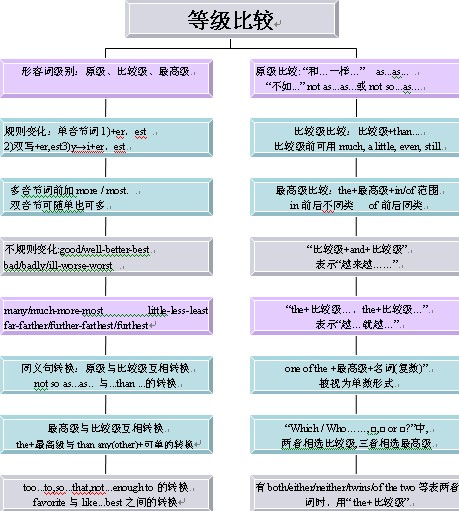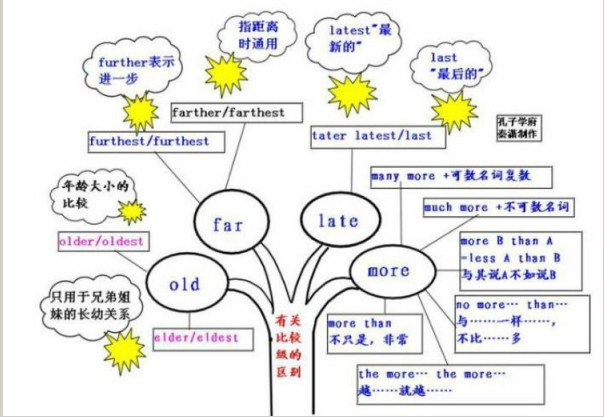本试题 “单词拼写。根据下列句子及所给汉语注释,写出空缺处各单词的正确形式。(每空只写一词)1.When his mother entered the room, he ______ to be reading.(假装)2....” 主要考查您对单词、词组
可数名词及其单复数
形容词的比较级
现在分词
一般过去时
等考点的理解。关于这些考点您可以点击下面的选项卡查看详细档案。
- 单词、词组
- 可数名词及其单复数
- 形容词的比较级
- 现在分词
- 一般过去时
单词和短语:
由两个以上的词组成的,没有完整的句子结构,但又有一定的语法和逻辑关系的词的组合就是短语或词组。短语又包括固定短语,和自由短语。
比如说,put off (推迟),look up(查阅,查字典)have a heavy heart(心情沉重)…我们都习惯称为短语或词组(phrase)。put off是由一个动词和介词组成的,但他在句子中充当一个动词的作用,也就是说在这个词组中,put 是词头(head of the phrase) 所以它是动词词组,或动词短语。
题型特点:
对于英语学习来说,词汇是基础,掌握并灵活运用英语单词对学好英语至关重要,它会直接影响到我们的听、说、读、写能力。从高考单词拼写试题来看,单词拼写把单词放在句中考查,不仅是单词拼写,而且还要考查单词的形式,即将单词的写与用结合起来。这一点主要是要求学生对词汇的应用要有所掌握,体现了学以致用,从而根据语境选用适当的词。因此,答题时必须认真阅读全句,弄懂句意,在理解的基础上考虑选用适当的词汇。所考词汇多为多音节词,多数单词均有不同的变化形式,一般不少于4个字母。
题型种类:
1、句子中被考查的单词突出,画横线,横线标有该单词的首字母,要求学生写出该单词的正确形式。
2、句子中被考查的单词突出,画横线,横线后的括号内注有汉语,要求学生写出该单词的正确形式。
例题解析:
(一)读懂句意,确定单词。
例如:The f____day of the week is Sunday. 该句意为“一周的第一天是星期天”,需要填的词的首字母是“f”,根据常识和序数词有关知识应填“第一”,故填 first。此类题还可考月份。
例如::September is the n ____ month of the year (答案:ninth)
(二)瞻前顾后,确定形式写出单词后,还要注意分析该单词是否需要变化形式。现分类说明如下:
1、名词一般考虑单、复数和所有格。
例1:Do you like white?We have shirts of different c____. 根据句意,可确定单词为“color”,通过前面的shirts和different两词可确定此处应用colors。
例2:September10 this T____Day. 根据句意,确定单词“Teacher”,它与Day之间存在所有格关系,将Teacher变为复数,再变为所有格,应填Teachers'。
2、形容调和副词这两类词学生极易混淆,做题时应仔细分析,慎重选择究竟用哪类词,有时还要考虑到形容词和副词“级”的变化。
例1:He was very a____with the man upstairs and began to shout, "Stop singing!" 根据句意,此处应填形容词原级angry。
例2:On Sundays, Children play h____in the park. 此处应填副词happily,副词修饰动词。
3、动词动词变化形式较为复杂,一般有五种:动词原形、第三人称单数形式、现在分词,过去式和过去分词。可综合考查学生运用英语知识的能力。
例1:Thank you very much for l____me your bike. 介词后动词用-ing形式,故填lending。
例2:When he was ten, he became i____in maths. become interested in 为固定词组,意为“对……感兴趣”,故此处应填interested。
4、数词注意确定用基数词还是序数词。
例1:There are t____months in a year. 此处应用基数词twelve。
例2:December is the t____month of the year. 此处应填序数词twelfth。
5、代词主要从人称代词、物主代词、反身代词、不定代词和疑问代词几方面考虑,有时还要考虑用单数还是用复数。
例1:Help y____to some fish, Jim. 根据句意,此处应用yourself.
例2:"Help y____to some fish, please." Mrs Green said to the twins. 根据句意,thetwins为复数,故填yourselves。
6、连词若前后两个词或句子存在转折、因果、并列、选择等关系,一般应填连词。
例1:She didn't go to school yesterday b____she was il1. 从句和主句互为因果关系,故填because。
例2:The football match still went on t____it was raining heavily. 该从句为让步状语从句,故应填though。
解题技巧:
以下是解单词拼写的基本程序:首先要仔细审题,明确大意。在句子缺词的情况下,尽量弄懂句子大意并根据已给出的语境,判断出所缺的单词,试将该单词放入句子当中,看是否能使句子完整,句意明确。注意词性,写出词形。在解题过程中,要特别注意根据句子中所缺成分,判断所缺单词的词类。
1、名词,就要注意单复数;
2、动词,就要注意主谓一致、时态和语态的一致性;
3、形容词和副词,就要注意形容词和副词之间的转化规则;
4、词组和短语,就要注意固定搭配。
重读句子,验证答案。完成拼写后,要把句子重读一遍,检查句子是否通顺,单词拼写是否准确无误,单词形式是否正确,如名词的数、格,动词的时态、语态、语气和非谓语形式,形容词、副词的级等。这一步很重要,因为差之毫厘,谬以千里。总而言之,高考单词拼写题既考查学生的词汇量,又考查学生在特定的语境中灵活运用词汇的综合应变能力。要想提高得分率,绝非一日之功。正如谚语所说:“Rome was not built in one day”。所以,考生应该以命题特点为指导,在平时的复习中运用构词法知识多读、多记、多练,并增强语感,辅以行之有效的解题方法,才能熟练掌握,灵活运用,避免出错。
题型拓展:
1、单纯的翻译题,考查考生对单词的记忆。例句:The little girl is wearing a____ (粉红色的)dress. (正确答案:pink)
2、根据语境要求,填入所写单词的适当形式。
例句:The story was first written in English and later____ (翻译) into Chinese.(正确答案:translated)
3、从词在拼写上有可能存在的“盲点”(相对难写、难记)考虑命题。
例句:The book gives a short ____(描述) of the city.(正确答案:description)
4、在有可能出现多个近似答案的情况下,对词的用法进行甄别。
例句:Very few people ____(成功) in losing weight these days.(正确答案:succeed)
5、从词在用法上有可能存在的“盲点”(相对少见的用法,在一般规律中考查特殊)考虑命题。
例句:All the boys were standing up ____(笔直). (正确答案:straight)
6、侧重选择多音节词汇(构成各单词的字母数一般都超过了7个)命题,考查考生对多音节词汇的把握程度。
例句:One of ____ (邻居) kept a very beautiful garden. (正确答案:neighbours或neighbors)
7、侧重选择词义较为生僻或使用率偏低的词汇命题,考查考生对单词拼写记忆的广泛程度。
例句:He turned on the television set hanging from the____ (天花板). (正确答案:ceiling)
8、侧重从词音与词形不相吻合的部分命题(包括不发音字母),考查考生对单词拼写记忆的准确程度。
例句:I usually just have a____ (三明治) for lunch. (正确答案:sandwich)
9、能根据语境的要求,将所给的中文提示(该提示给人以名词或动词的假象)转译成正确的英语表现形式。
例句:I changed into my sports shoes so that I could walk more____(舒服). (正确答案:comfortably)
10、对近义词不同搭配用法的一般常识,在有可能出现多个答案的情况下,对词的用法进行反复推敲,考生应对最常用词汇的易混易错现象给予注意。
例句:A fence at the back of garden (分开) us from the neighbours.(正确答案:separates或separated)
可数名词:
是指能以数目来计算,可以分成个体的人或东西;因此它有复数形式,当它的复数形式在句子中作主语时,句子的谓语也应用复数形式。
可数名词复数的规则变化:
| 情况 | 构成方法 | 读音 | 例词 |
| 一般情况 | 加 –s | 1.清辅音后读/s/; 2.浊辅音和元音后读/z/; |
map-maps bag-bags car-cars |
| 以s,sh,ch,x等结尾的词 | 加 -es | 读 /iz/ | bus-buses watch-watches |
| 以ce,se,ze,(d)ge等结尾 的词 |
加 -s | 读 /iz/ | license-licenses |
| 以辅音字母+y结尾的词 | 变y 为i再加es | 读 /z/ | baby-babies |
1)以y 结尾的专有名词,或元音字母+y结尾的名词变复数时,直接加s变复数:
如:two Marys the Henrys monkey---monkeys holiday---holidays
比较:层楼:storey---storeys story---stories
2)以o 结尾的名词,变复数时:
a. 加s,如: photo---photos piano---pianos
b. 加es,如:potato--potatoes tomato--tomatoes
c. 均可,如:zero---zeros / zeroes
3)以f或fe 结尾的名词变复数时:
a. 加s,如: belief---beliefs roof---roofs safe---safes gulf---gulfs;
b. 去f, fe 加ves,如:half---halves knife---knives leaf---leaves wolf---wolves wife---wives life---lives thief---thieves;
c. 均可,如:handkerchief: handkerchiefs / handkerchieves
可数名词复数的不规则变化:
1)child---children foot---feet tooth---teeth mouse---mice man---men woman---women
注意:与 man 和 woman构成的合成词,其复数形式也是 -men 和-women。
如:an Englishman,two Englishmen. 但German不是合成词,故复数形式为Germans;Bowman是姓,其复数是the Bowmans。
2)单复同形 如:
deer,sheep,fish,Chinese,Japanese
li,jin,yuan,two li,three mu,four jin
但除人民币元、角、分外,美元、英镑、法郎等都有复数形式。如:
a dollar, two dollars; a meter, two meters
3)集体名词,以单数形式出现,但实为复数。
如:staff people police cattle 等本身就是复数,不能说a staff a people,a police,a cattle,
但可以说a person,a policeman,a head of cattle, the English,the British,the French,the Chinese,the
Japanese, the Swiss 等名词,表示国民总称时,作复数用。
如:The Chinese are industries and brave. 中国人民是勤劳勇敢的。
4)以s 结尾,仍为单数的名词,如:
a. maths,politics,physics等学科名词,为不可数名词,是单数。
b. news 是不可数名词。
c. the United States,the United Nations 应视为单数。
The United Nations was organized in 1945. 联合国是1945年组建起来的。
d. 以复数形式出现的书名,剧名,报纸,杂志名,也可视为单数。
"The Arabian Nights" is a very interesting story-book.
<<一千零一夜>>是一本非常有趣的故事书。
5) 表示由两部分构成的东西,如:glasses (眼镜) trousers, clothes ;
若表达具体数目,要借助数量词 pair(对,双); suit(套); a pair of glasses; two pairs of trousers
6)另外还有一些名词,其复数形式有时可表示特别意思,如:goods货物,waters水域,fishes(各种)鱼
复合名词的复数形式:
名词作定语名词作定语一般用单数,但也有以下例外。
1)用复数作定语。
如:sports meeting 运动会
students reading-room 学生阅览室
talks table 谈判桌
the foreign languages department 外语系
2)man, woman, gentleman等作定语时,其单复数以所修饰的名词的单复数而定。
如:men workers
women teachers
gentlemen officials
3)有些原有s结尾的名词,作定语时,s保留。
如:goods train (货车)
arms produce 武器生产
customs papers 海关文件
clothes brush衣刷
4)数词+名词作定语时,这个名词一般保留单数形式。
如:two-dozen eggs 两打/(二十四个鸡蛋)
a ten-mile walk 十里路
two-hundred trees 两百棵树
a five-year plan 一个五年计划
可数名词单复数知识体系:

不同国籍人的单复数:
国籍
总称(谓语用复数)
单数
复数
中国人
the Chinese
a Chinese
two Chinese
瑞士人
the Swiss
a Swiss
two Swiss
澳大利亚人
the Australians
an Australian
two Australians
俄国人
the Russians
a Russian
two Russians
意大利人
the Italians
an Italian
two Italians
希腊人
the Greek
a Greek
two Greeks
法国人
the French
a Frenchman
two Frenchmen
日本人
the Japanese
a Japanese
two Japanese
美国人
the Americans
an American
two Americans
印度人
the Indians
an Indian
two Indians
加拿大人
the Canadians
a Canadian
two Canadians
德国人
the Germans
a German
two Germans
英国人
the English
an Englishman
two Englishmen
瑞典人
the Swedish
a Swede
two Swedes
形容词比较级概念:
大多数形容词(性质形容词)有比较级,用来表示两个人或事物之间的比较“较……”。
如:I am taller than you.
形容词比较级特殊用法:
1、没有比较对象的比较结构:
所谓没有比较对象的比较结构不是指省略而言,而是指并非真正的比较。
例如:The car runs faster than110 miles. 那辆车时速为110多英里。
There is more than one solution to the problem. 这个问题的解决办法不止一个。
The daily cost in an average hospital in the United States can run as high as $250. 在美国普通医院的每天的费用可高达250美元。
2、用比较级的形式表达最高级的意思:
在这种情况下,往往是将一个人或是一件事与其他所有的人或事相比较。注意别忘了常在比较状语中用any, other, else类的字眼,以将比较主体排除在比较对象以外,因为自己不可以与自己相比较。
例如:He is taller than any one else in our class. 他在我们班比其他任何都高。
Iron is more useful than any other metals. 铁比其他任何金属更有作用。
3、no+比较级+than的结构表示“A和B一样不……”:
例如:She runs no faster than her sister.她与她妹妹一样跑不快。
Tom is no wiser than John. 汤姆和约翰一样没有聪明才智。
He is no richer than his brother. 他与他弟弟一样不富有。
4、汉语可以说“昆明的气候比兰州好”。英语必须加that:
例如:The climate of Kunming is better than that of Lanzhou.
5、英语比较级常译作“较…”、“…一些”等,但不等于汉语的“更…”。汉语的“更…”须用“still”或“even”来表示:
如:This book is even more difficult than that one. 这本书比那本书更难。
6、有些情况下,汉语不用“较”等字眼,英语则须用比较级:
如:Will the younger people give their seats to old people? 请年轻人把座位让给老年人好不好?
形容词比较级的用法:
1、比较级用于二者的比较,其结构是:含有形容词比较级的主句+从属连词than引导的从句(从句中常省去意义上和主句相同的部分)。
如:Li is older than Zhou. 李比周年纪大。(从句中省去了is old)
There are more children in this nursey than in that one. 这个托儿所的孩子比那个托儿所多。(从句中省去了there are children)
After two years' physical training, she is healthier and stronger. 经过两年的体力锻炼,她(比以前)健康强壮多了。(注意这里省去了从句than she was)
We are much better off than ever before. 我们的生活比过去任何时候都要好得多。(than后省去了we were)
Paul weighs less than harry. 保尔的体重比哈利轻。
Mary is less clever than Jane. 玛丽不如简那么聪明。
2、可修饰比较级的词:
1)a bit, a little, rather, much, far, by far, many, a lot, lots, a great deal, any, still, even等
2)还可以用表示倍数的词或度量名词作修饰语。
3)以上词(除by far)外,必须置于比较级形容词或副词的前面。
典型例题:
1)—Are you feeling ____?
—Yes,I'm fine now.
A. any well
B. any better
C. quite good
D. quite better
答案:B. any可修饰比较级,quite修饰原级,well的比较级为better.
2)The experiment was____easier than we had expected.
A. more
B. muchmore
C. much
D. moremuch
答案:C. much可修饰比较级,因此B,C都说得通,但easier本身已是比较级,不需more,因此C为正确答案。
3)If there were no examinations, we should have___at school.
A. the happiest time
B. a more happier time
C. much happiest time
D. a much happier time
答案:D.
注:many, old和far用法:
1)如果后接名词时,much more+不可数名词 many more+可数名词复数
2)old有两种比较级和最高级形式:older/oldest和elder/eldest。elder,eldest只用于兄弟姐妹的长幼关系。
如:My elder brother is an engineer.
3)far有两种比较级,farther,further在英语中两者都可指距离。在美语中,father表示距离,further表示进一步。
如:I have nothing further to say.
3、比较级中的两个特殊作用的结构:
1)The+比较级+句子,表示的意义是“越(怎么样就)越(怎么样)”,在这个结构中的两个“比较级”不要求一定词性相同,它们各自的词性要依句子的需要而定;
2)和比较级+and+比较级。表示的意义是“越来越(怎么样)”,在这个结构中的两个“比较级”则要求词性相同。
例如:The harder you work at your study, the better academicrecords you will have. 你学习越努力,你的成绩就越好。
The more we have, the more we want. 人欲无穷。
When winter is coming, it gets colder and colder. 冬天来临之际,天越来越冷了。
He became less and less satisfied with the foot ball team's performance. 他对足球队的表现越来越不满意了。
形容词比较等级知识体系:

特殊形容词比较级变化:

现在分词的概念:
现在分词(PresentParticiple)(又称-ing形式),是分词的一种,是非限定动词,即在句子里面不能单独充当谓语,但能充当其它的一些成分(定语,表语,补语和状语)。一般式:doing;一般被动式:being done;完成式:having done;完成被动式:having been done。所有否定式都是在-ing前面加not。
现在分词的用法:
1)做表语:
如:He was very amusing.
That book was rather boring.
很多动词的现在分词都可以作表语:exciting, interesting, encouraging, disappointing, confusing, touching, puzzling.
2)作定语:
上面所出现的现在分词都可以用作定语,修饰一个名词:
如:That must have been a terrifying experience.
I found him a charming person.
现在分词短语还可以放在名词的后面修饰名词,相当于一个定语从句:
如:There are a few boys swimming in the river.
There is a car waiting outside.
3)作状语:
现在分词短语可以表示一个同时发生的次要的或伴随的动作:
如:Following Tom, we started to climb the mountain.
Opening the drawer, he took out a box.
Taking a key out of his pocket, he opened the door.
现在分词短语还可以表示原因,相当于一个原因状语从句:
如:Not knowing her address, we couldn't get in touch with her.
Being unemployed, he hasn't got much money.
现在分词短语还可以表示时间,相当于一个时间状语从句:
如:Hearing the news, they all jumped with joy.
Returning home, he began to do his homework.
Jim hurt his arm while playing tennis.
Be careful when crossing the road.
Having found a hotel, we looked for some where to have dinner.
Having finished her work, she went home.
4)作宾补:
现在分词在一些动词之后可以做宾语的补语:
例如:see, hear, catch, find, keep, have等。
如:I see him passing my house every day.
I caught him stealing things in that shop.
I smelt something burning.
She kept him working all day.
现在分词其他用法解析:
1、现在分词一般式的用法:
现在分词的一般式所表示的动作与主语动作同时发生:
如:When we arrived, we found him sleeping. 我们到达时发现他在睡觉。
Living in the 示的动作也可略早于或迟于谓语动作,但两者之间没有时间间隔:
如:Seeing nobody at home, he decided to leave a note. 发现没有在家,他决定留个字条。
He went home, finding the door locked. 他回到家,发现门是锁着的。当现在分词所表示的动作略迟于谓语动作时,现在分词通常位于句末。
2、现在分词完成式的用法:
现在分词的完成式主要表示发生在谓语动作之前的动作:
如:Having been there once, she knew the place quite well. 由于去过那儿一次,她对那地方很熟悉。
Having failed twice, he didn't want to try again. 他已经失败了两次,不想再试了。
注:(1)现在分词的一般式和完成式均可表示已完成或先于谓语的动作,但有区别:现在分词所表示的动作虽然可以先于谓语动作,但两者之间没有时间间隔,而现在分词的完成式所表示先于谓语的动作则与谓语动作有一定的时间间隔:
如:Locking the door, he went out. 锁好门之后,他就出去了。
Having invited him here to speak, we'd better go to his lecture. 既然我们请了他来作报告,我们最好去听一下。
有时即使是分词动作与谓语动作几乎同时发生,但如果要强调分词动作的完成性,也应用现在分词的完成式:
如:Having bought our tickets, we went into the theatre. 我们买好票后就走进剧场。
(2)现在分词的完成式一般不用作定语:
误:Do you know anyone having lost a cat? 你知道有谁丢了一只猫吗?
误:I want to talk to the person having broken the window. 我想同打破窗户的人谈谈。
若将以上现分词的完成式改为一般式也不可以(因为现在分词作后置定语时通常只表示与谓语动作同时或几乎同时发生的动作,而不能先于谓语动作而发生):
误:I want to talk to the person breaking the window.
3、现在分词被动式的用法:
当要表示一个被动动作时,现在分词就用被动形式。现在分词的一般式和完成式均有被动式形式:
(1)现在分词一般式的被动式:主要表示现在正在进行的动作,也可表示与谓语动作同时发生的动作:
如:Who is the woman being operated on? 正在动手术的女人是谁?
I saw him being taken away by the police. 我看见他被警察带走。
注:有时现在分词一般式的被动式所表示的动作也可发生在谓语动作之前(此时的现在分词通常用于表示原因,且多为状态动词):
如:Not having a car, he finds it difficult to get around. 由于没车,她感到行动很困难。
(2)现在分词完成式的被动式:主要表示发生在谓语动词之前且已经完成的动作。
如:The subject having been opened, he had to go on with it. 话题已经开始了,他不得不谈下去。
Having been written inhaste, the book has many mistakes. 这书因写得仓促,所以错误不少。
比较:Being so ill, she can't go to school. 由于病得那么严重,她不能去上学。
Having been ill for a long time, he needed time to recover. 由于病了很长时间,他需要一段恢复的时间。
一般过去时的概念:
一般过去时表示过去某个时间里发生的动作或状态;过去习惯性、经常性的动作、行为;过去主语所具备的能力和性格。
一般过去时的用法:
1、表示过去发生的动作或存在的状态,常与表示过去时间的副词如:yesterday,last week,two hours ago等连用。
如:My family moved here five years ago. 我家五年前搬到了这里。
I was born in 1973. 我生于1973年。
2、表示过去一段时间经常或反复发生的动作。这时可与频度副词如:often,usually,always等连用。
如:He always worked in tonight those days. 那些日子他总是工作到深夜。
I often left on business in 1987. 1987年我经常出差。
注:表示“过去经常,而今不再”时,要用usedto.
如:I used to read newspaper after breakfast. 我过去经常早饭后看报纸。(意指现在已不是这样)
The children often swam in this river. 孩子们过去经常在这条河里游泳。
3、表示过去发生的一连串动作。
如:He put down the heavy box, took out the keys, and opened the door. 他放下这沉重的箱子,掏出钥匙开了房门。
注:过去发生的一连串动作,若用and,or,but等并列连词连接,则一律用过去式。
如:They moved the chairs to the table, sat down and began to have supper. 他们把椅子搬到桌边,坐下开始吃饭。
4、在时间和条件状语从句中,用一般过去时表示过去将来的动作。
如:He said that he would let me know as soon as he got the information. 他说他一得到消息就立即让我知道。
Mary told me that she would stay at home if it rained. 玛丽告诉我如果下雨她就呆在家里。
一般过去时的特别用法:
1、句型:It is time for sb. to do sth "到……时间了" "该……了"。
例如:It is time for you to go to bed.你该睡觉了。
It is time that sb.did sth. "时间已迟了" "早该……了"。
例如:It is time you went to bed. 你早该睡觉了。
2、would(had)rather sb.did sth. 表示'宁愿某人做某事'。
例如:I'd rather you came tomorrow. 还是明天来吧。
3、wish, wonder, think, hope等用过去时,作试探性的询问、请求、建议等,而一般过去时表示的动作或状态都已成为过去,现已不复存在。
例如:I thought you might have some. 我以为你想要一些。
比较:Christine was an invalid all her life.(含义:她已不在人间。)
Christine has been an invalid all her life.(含义:她现在还活着)
Mrs. Darby lived in Kentucky for seven years.(含义:达比太太已不再住在肯塔基州。)
Mrs. Darby has lived in Kentucky for seven years.(含义:现在还住在肯塔基州,有可能指刚离去)
注意:用过去时表示现在,表示委婉语气。
1)动词want, hope, wonder, think, intend等。
例如:Did you want any thing else? 您还要些什么吗?
I wondered if you could help me. 能不能帮我一下。
2)情态动词could, would。
例如:Could you lend me your bike? 你的自行车,能借用一些吗?
与“单词拼写。根据下列句子及所给汉语注释,写出空缺处各单词的正...”考查相似的试题有:
- 单词拼写。请把答案的完整形式写在以下横线上。1. I can't c ______ on my work when I'm tired.2. She pulled the drowning ...
- 单词拼写。根据所给首字母和中文提示完成各句,使句意通顺。1. There was adequate sunshine in Xinjiang this summer, a____...
- 第Ⅱ卷(客观题共35分)一、根据语境、首字母或汉语提示写出词汇(共2分)76. How many people p__________ in the opening ceremo...
- Soon after he left the hotel he was lost. So he decided to ask for ___________.A.purposesB.directionsC.approachesD...
- 、----What ______ do you focus on when choosing a mobile phone for personal use?----Its functions and stand-by time....
- —How much is the T-shirt ?—It is __________ 65 dollars.A.worthB.costC.worthyD.paid
- ________ the right kind of training, these teenage soccer players may one day grow the international stars. (2009江西...
- 单词拼写。1. The lady thinks her husband is very r_______, because he is very honest and positive.2. However, all hop...
- — You speak such goodEnglish.Have you been abroad before?— Yes.I ________ in Britain four years ago.[ ]A. studiedB. h...
- — I wonder how long you _____ in Beijing.— Just for the weekend, then I had to attend a conference in Tianjin.A. will...